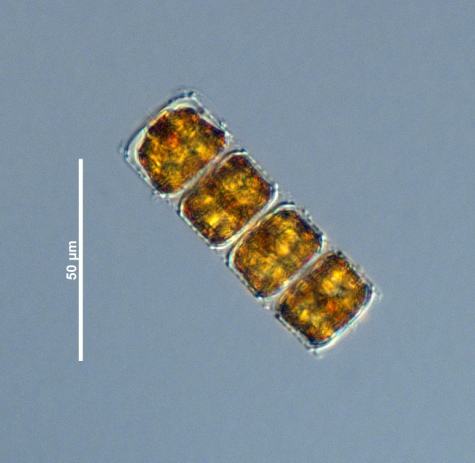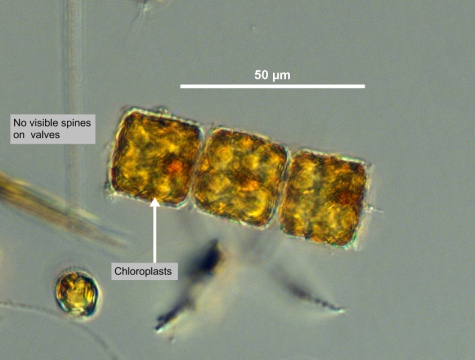

|
Synonym(s)
Heterotypic
A difference in type. In naming species, a heterotypic synonym is one that comes into being when a taxon becomes part of a different taxon. Compare to homotypic.
(heterotypic)(Guiry and Guiry 2011)
Classification
(Guiry and Guiry 2011)
Lifestyle
Gamete
A reproductive cell (sperm or ovum) that can combine with another reproductive cell to create a new individual.
gametes and auxospores. Sexualisation is positively correlated with light intensity. High light intensity and ClosePhotoperiod
The amount of time in a day that an organism is exposed to daylight. This varies between seasons, with photoperiods being longer in the summer and shorter in the winter.
photoperiod of 16 h are optimal for sexualisation of cells. Sexualisation is inhibited by long and continuous illumination (Lin and Weng 1994).Description
Nucleus
(plural: nuclei) In eukaryotic cells, a membrane-bound organelle that contains the cell's genetic information; the nucleus controls the activities of the cell by controlling gene expression.
nucleus is roughly central, in a CloseCytoplasm
In a eukaryotic cell, a gel-like substance within the cell membrane that contains all the organelles except for the nucleus.
cytoplasmic cord, connecting centres of valves (Cupp 1943), or sometimes described as elongated and bi-lobed, with each lobe pressing against the valve ends (Holmes 1977). Cell colour is yellow-brown (Guiry 2011).Marginal process
In some diatoms, a long, coarse external tube through the frustule (Tomas 1997).
marginal CloseLabiate process
In diatoms, a simple slit in the valve wall with two internal lips, one on each side of the slit. They can be useful in identification because they are positioned differently in different species (Horner 2002).
labiate process. Numerous CloseStrutted process
(how is this different than marginal process?) In some diatoms, a narrow tube through the frustule that is usually associated with the secretion of chitin. It may appear as a marginal process or as a simple pore in the valve wall (Spaulding et al. 2010).
strutted processes on valve face and margin. Long CloseOccluded
Blocked.
occluded CloseProcess
A natural projection or appendage on an organism.
processes in marginal zone (types of processes not differentiated with CloseLM
(light microscopy) "Using a microscope in which a beam of light passes through optical lenses to view an image of the specimen" (MCM LTER 2010).
LM)" (Hasle and Syvertsen 1997). The valve face is CloseRadial
(symmetry) Describing a shape that many axes of symmetry. That is, it does not have a left and right like humans do (bilateral symmetry), but can be divided into equal halves no matter where you place the axis. Some examples of radially symmetrical organisms include sea stars and centric diatoms like Thalassiosira.
radially CloseStriae
(referring to pores in diatoms) In diatoms, a striation or row of pores on the valve face. "In centric diatoms, striae may be radial, running from the centre of the valve to the margin ... In pennate diatoms, striae may be parallel to the median line of the valve or raphe" (Horner 2002).
striated. CloseIntercalary bands
Girdle bands that are furthest away from the valve (Smithsonian 2011).
Intercalary bands are collar-shaped, relatively delicate and indistinct except in older cells. CloseMantle
In diatoms, "the part of a valve that extends from the valve face, forming the valve edge." It is visible when the frustule is viewed in girdle view (Spaulding 2010).
"Mantle surface delicately CloseAreolated
Synonym: perforated. Describing a surface that has many holes. Often used to describe the valve surface of diatom frustules.
areolated- ClosePunctated
Marked with tiny coloured spots or depressions.
punctated, ClosePunctum
(plural: puncta) A sharp tip or small point on any part of an organism's anatomy.
puncta in irregular rows." Puncta on intercalary bands are irregularly arranged (Cupp 1943).Measurements
Pervalvar axis
The axis through the centre point of the two valves of a frustule. This axis is perpendicular to the valve face.
(pervalvar axis): 20 - 96 μmDiameter: 15 - 75 μm
Radial Close
Ribs
Features that provide support to other structures in the cell.
ribs on valve face: >30 in 10 μmPuncta on intercalary bands: ∼16 in 10 μm
(Cupp 1943, Hasle and Syvertsen 1997, Kraberg et al. 2010)
Similar species
Harmful effects
Habitat
Distribution
Temperate to warm water regions (Hasle and Syvertsen 1997).
Occurs mainly in spring but also in the summer in Northern European seas (Kraberg et al. 2010). Has bloomed in late winter around the Northern Adriatic Sea (Umani and Beran 2003). Common in spring and autumn around northwest Spain (Casas et al. 1999). One of the most abundant species during winter and spring in the Subtropical Convergence region near New Zealand (Chang and Gall 1998).
"Temperate species. Common but not abundant off California. Reported in Gulf of California and north to Scotch Cap, Alaska." (Cupp 1943).
Growth conditions
Irradiance
Amount of solar energy per unit area on a surface (units: μE m-2 sec-1, where E is an Einstein, a mole of photons).
irradiance due to reduction in 15N-nitrate uptake (Döhler and Biermann 1987). Low UV-B irradiance (∼440 J m-2 d-1) slightly increased the biomass, as compared to cells with no exposure to UV-B; while higher irradiance (∼720 J m-2 d-1) decreased the protein and pigment content (Döhler 1984).Environmental Ranges
Temperature range (°C): -1.948 - 29.468
Nitrate (μmol L-1): 0.053 - 13.830
Salinity (PSU): 31.191 - 39.226
Oxygen (mL L-1): 4.344 - 8.713
Phosphate (μmol L-1): 0.046 - 1.446
Close
Silicic acid
A general term to describe chemical compounds containing silicon, oxygen and hydrogen with a general formula of [SiOx(OH)4-2x]n. Diatoms polymerize silicic acid into biogenic silica to form their frustules (Azam and Chisholm 1976).
Silicate (μmol L-1): 0.648 - 28.931(OBIS 2011, cited in EOL 2011)
Bloom characteristics
References
Casas, B., Varela, M. and Bode, A. 1999. Seasonal succession of phytoplankton species on the coast of A Coruña (Galicia, northwest Spain). Boletin del Instituto Español de Oceanografia. 15(1-4): 413-429.
Chang, F. H., Gall and M. 1998. Phytoplankton assemblages and photosynthetic pigments during winter and spring in the Subtropical Convergence region near New Zealand. New Zealand Journal of Marine and Freshwater Research. 32(4): 515-530.
Cupp, E. E. 1943. Marine Plankton Diatoms of the West Coast of North America. University of California Press. Berkeley, California. 238.
Döhler, G. 1984. Effect of UV-B radiation on the marine diatoms Lauderia annulata and Thalassiosira rotula grown in different salinities. Marine Biology. 83(3): 247-253.
Döhler, G. and Biermann, I. 1987. Effect of UV-B irradiance on the response of 15N-nitrate uptake of Lauderia annulata and Synedra planctonica. Journal of Plankton Research. 9(5): 881-890.
Encyclopedia of Life (EOL). 2011. Lauderia annulata Cleve. http://www.eol.org/pages/897284. Accessed 27 Aug 2011.
Guiry, M. D. 2011. Lauderia annulata Cleve, 1873. http://www.marinespecies.org/aphia.php?p=taxdetails&id=149135. Accessed 27 Aug 2011.
Guiry, M. D. and Guiry, G. M. 2011. Lauderia annulata Cleve. http://www.algaebase.org/search/species/detail/?species_id=59208. Accessed 27 Aug 2011.
Hasle, G. R., Syvertsen, E. E. 1997. Marine diatoms. In: Tomas, C. R. (ed.) Identifying marine Phytoplankton. Academic Press, Inc., San Diego. 5-385.
Holmes, R. W. 1977. Lauderia annulata - a marine centric diatom with an elongate bilobed nucleus. Journal of Phycology. 13(2): 180-183.
Horner, R. A. 2002. A Taxonomic Guide To Some Common Phytoplankton. Biopress Limited, Dorset Press, Dorchester, UK. 200.
Ishii, K., Ishikawa, A. and Imai, I. 2009. Marine diatoms emerged from in situ surface sediment in a temperate embayment. Phycologia. 48(4, suppl.): 48.
Kraberg, A., Baumann, M. and Durselen, C. D. 2010. Coastal Phytoplankton: Photo Guide for Northern European Seas. Verlag Dr. Friedrich Pfeil, Munchen, Germany. 204.
Lin, J. and Weng, S. 1994. Production of gametes and auxopores in the centric diatom Lauderia borealis Gran. Oceanologia et limnologia sinica/Haiyang Yu Huzhao. 25(6): 601-605.
Ocean Biogeographic Information System (OBIS). 2011. Lauderia annulata. http://www.iobis.org/mapper/?taxon_id=460503. Accessed 27 Aug 2011.
Reigman, R., de Boer, M., de Senerpont Domis, L. 1996. Growth of harmful marine algae in multispecies cultures. Journal of Plankton Research. 18(10): 1851-1866.
Sommer, U. 1994. Are marine diatoms favoured by high Si:N ratios? Marine Ecology Progress Series. 115(3): 309-315.
Umani, S. F. and Beran, A. Seasonal variations in the dynamics of microbial plankton communities: First estimates from experiments in the Gulf of Trieste, Northern Adriatic Sea. Marine Ecology Progress Series. 247: 1-16.
